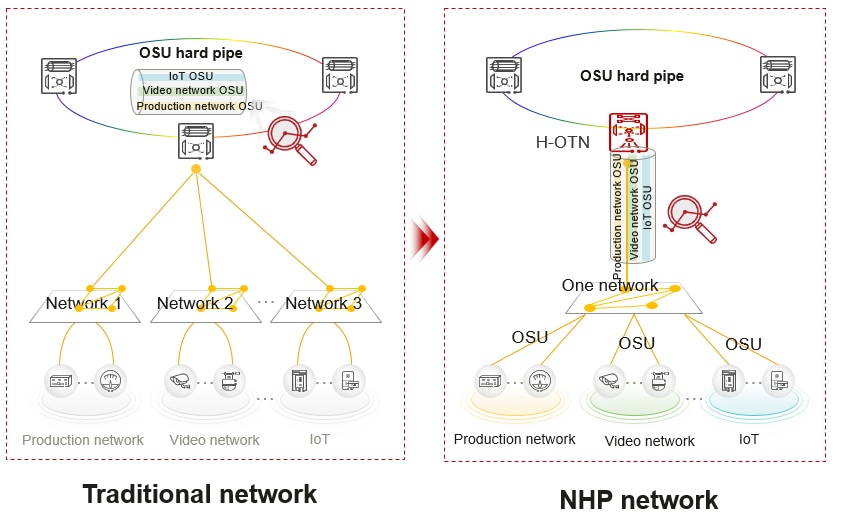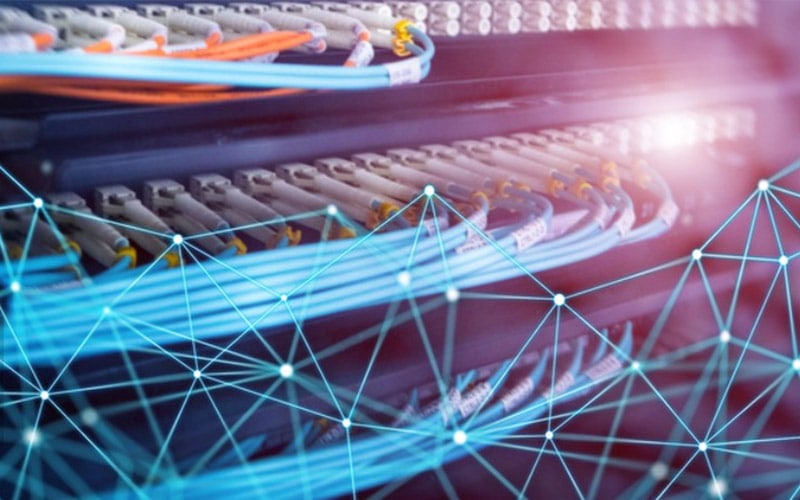New Solutions
Native Hard Pipe Network: An Optical Foundation for Industries to Go Digital
A simplified, integrated optical network can help enterprises overcome the digitalization bottleneck caused by multiple co-existing networks.


By Zhang Chi, Optical Marketing Execution Dept., Huawei
Electric power and transportation provide essential services for national economies and people's livelihoods and as such form a vital part of the digital transformation process.
In the electric power industry, the energy Internet emerged on third-generation power grids at the end of the 20th century, supporting new power systems that use clean energy and run on smart, ultra-high voltage power grids and architecture. In the transportation industry, China's 2019 Program of Building National Strength in Transportation set similar requirements: first, deeply integrate advanced IT into transportation to digitalize the system. And second, establish an integrated transportation system that connects the sea, air, road, rail, and freight transportation.
Industries need to digitalize both infrastructure and services. Digital services need to rely on digital infrastructure equipped with comprehensive sensing and connectivity capabilities. Native hard pipes are an underlying technology for digital infrastructure that supports secure, real-time services for multiple industries.
Multiple coexisting networks result from new digital services
Industrial digitalization is a long-term, continuous process that requires regular adjustments to match social development and business changes. As new services emerge, we've seen increasing numbers of communication networks being built to support them.
For example, rapidly developed new services in the electric power industry, including distribution automation, intelligent inspection, and distributed clean energy, have resulted in the construction of multiple networks. Distribution automation in particular, has become indispensable to modern power grid management and most customers now prefer to build independent, fiber-optic communication networks for power distribution.
As quickly expanding power facilities increase installed generation capacity and transmission line length, manual inspection is no longer enough. This has driven the adoption of intelligent inspection that requires networks with high bandwidth, low latency, and high security, so many customers choose to build new networks for this service.
Under carbon peak and carbon neutrality goals, more distributed clean energy systems need to be connected and the underlying power IoT must support power grid information collection and industrial control services. Independent IoT networks that provide end-to-end SLAs and support service isolation are necessary to meet the high security requirements of these services.

Similar problems exist in the transportation industry. For example, metro station operations systems run multiple services, including passenger information, automated ticketing, and video surveillance. These service systems are usually built separately, meaning each has its own communication network.
The passenger information system, for example, provides passenger notices, service times, emergency warnings, and other dynamic information, making it a critical production service requiring an independent secure network with real-time capabilities. The automated ticketing system, which has evolved over the past 20 years from reading magnetic cards to processing mobile payments, also needs a separate network due to strict security requirements. With maturing video surveillance technology, yet another network is needed for real-time surveillance, dispatch and command, video conferencing, and other modern video services. Each needs an underlying communication system that’s secure, stable, and reliable, and that enables simple O&M.

Integrated, simplified optical networks
These are just a few examples of how the new services brought by industrial transformation often lead to multiple coexisting networks, which results in repeated network investment, complex O&M, low utilization, and insufficient security.
They need to be integrated for industrial digitalization to proceed for multiple reasons.
First, the emerging global consensus on low-carbon, environmentally friendly development is heavily influencing evolution plans for communication networks. Multiple coexisting networks simply waste too many resources. Second, simplifying the architecture of communication networks to avoid complex operations across multiple layers will speed up the rollout of new services as they emerge. Finally, the complex O&M and low efficiency generated by these redundant networks are too costly for many enterprises seeking to improve management efficiency by going digital.
Therefore, these networks need to be integrated, which requires the ability to create a single simplified network that supports end-to-end physical isolation of services.
From NHP to H-OTN
Hard pipe optical transmission technologies, like PDH and SDH, have been used in the electric power and transportation industries over the past 40 years to ensure stable and secure operations of production transport networks.
However, as more industries go digital, new problems, like those mentioned above, have occurred. Huawei has thus launched the native hard pipe (NHP) network supported by optical service unit (OSU) technology, a hard pipe technology similar to PDH and SDH. The NHP network is a simplified optical network that supports end-to-end hard pipe isolation by extending the use of OSU technology from WAN to access networks. As a hard pipe technology, OSU can physically isolate different services.

Comparison between traditional network architecture and NHP network architecture
With OSU-A technology, NHP networks replace multiple traditional access networks with one P2MP fiber-optic network. Multiple coexisting access networks – for example, for distribution automation and intelligent inspection in electric power and passenger information and automated ticketing in transportation – are integrated and multiple services are transmitted through different OSUs, ensuring each service is physically isolated. This saves resources and helps enterprises become green and low-carbon.
NHP networks have three distinct advantages:
First, it is more secure. Digital services are carried through hard pipe OSUs from terminals to the access network and then to the WAN, which enables end-to-end physical isolation, effectively ensuring service security.
Second, it is faster. As a native hard pipe technology, OSU provides deterministic ultra-low latency and zero jitter, enabling real-time services.
Third, it is more efficient. The simplified architecture of NHP networks can reduce enterprise management costs by improving O&M efficiency and enabling rapid service rollout.
At HUAWEI CONNECT 2021, Huawei launched a key component of NHP networks: H-OTN, an optical communication product that integrates hard pipes. H-OTN is based on OSU hard pipe technology, and has an innovative point-to-multipoint (P2MP) OTN architecture.
We’ve been working with State Grid Shanxi Information & Telecommunications to explore H-OTN and the SDH + OSU dual-plane solution since 2016. This new solution further deploys OSU on terminal access points of the power distribution network to build an end-to-end native hard pipe network.
Native hard pipe technology is the ideal tool for deepening industrial digitalization. It can provide high-security, high-reliability, low-latency, and high-bandwidth transport networks for various industries such as electric power and transportation. The launch of the H-OTN will also open up infinite possibilities for digital network infrastructure, lighting the way forward for industrial digitalization.
Read more about the Huawei OptixTrans H-OTN device.
- Tags:
- Optical Networks






